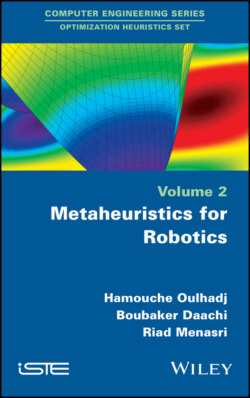Читать книгу Metaheuristics for Robotics - Hamouche Oulhadj - Страница 5
Оглавление
Preface
Optimization deals with methods that make it possible to optimize the use, operation and performance conditions of a system, whether it is physical or related to human activity. Situated at the crossroads of several disciplines, namely applied mathematics, computer science and artificial intelligence, optimization makes it possible to quickly find a solution to numerous problems which would otherwise be more difficult to solve relying solely on restricted mathematical analysis.
Based on heuristics or even metaheuristics at a higher level, optimization methods provide operational solutions, which are not necessarily optimal solutions but eligible suboptimal solutions, so-called acceptable solutions, because they demonstrate the level of performance required to reach a goal without conflicting with associated constraints. A number of problems whose resolution is based on optimization methods can be provided as examples:
— in finance, tax optimization is a means to minimize legal taxation;
— in databases, query optimization makes it possible to improve the accessibility of shared data, in particular by reducing transaction time;
— in telecommunications networks, routing optimization is a method for finding suitable paths for data exchange;
— in robotics, optimization allows, to take just one example, the identification of the best configurations (joint variables) that a robot must undergo in order to efficiently perform a task;
— in computer science, optimizing the code of a program makes it possible to reduce the memory space occupied and to increase the convergence time.
The applications outlined above are inherently very complex, which raises the problems of implementing accurate mathematical methods that provide admissible solutions without having to mobilize huge computational resources. In these circumstances, we are limited to considering approximated solutions, which are suboptimal solutions, but acceptable, ones since they guarantee goal realization while satisfying constraints.
In this book, we will address issues specifically related to the field of medical robotics. The focus of the applications being considered is on trajectory planning for redundant manipulative arms (articulated robots) within the context of surgical gesture assistance, and robust control for effort compensation or physical assistance in disability situations (exoskeleton). These applications are presented in detail, with the aim of understanding with the utmost clarity the problems to be solved, as well as the choices made to find effective solutions within a reasonable time frame.
The methods developed make use of optimization metaheuristics, which are high-level abstraction algorithms. Unlike heuristics, which are computational processes, often informally and “individually” adapted to specific problems, metaheuristics are general algorithms applicable to a very wide range of optimization problems, without the need to resort to a fundamental modification of the structure of these algorithms. The methods studied and results achieved are commented on and presented in detail for each of the applications addressed. Although the proposed methods are developed within the context of their application to medical robotics, their generic nature allows them to be easily expanded to other optimization problems which do not necessarily fall within the same scope of application.
Hamouche OULHADJ
Boubaker DAACHI
Riad MENASRI
November 2019
